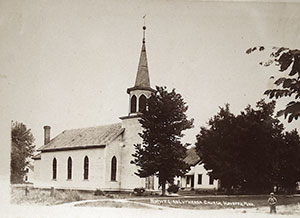
Before people had clocks and wristwatches, bells rang out the time of day. Centuries later, but still before electricity provided conveniences such as fire sirens, bells were a source of community communication – sometimes summoning people out of their homes, sometimes sending children back home. In the early 1900s, there were bells all around Houston, Minn. – according to town history writer, Ingrid Julsrud, in her 1993 book, “Remembering Old Times.”
A bell rested high on a post at the southwest corner of Cedar and Grant Streets, at that time by Rowland’s Hardware Store. That was the fire bell, which not only called for citizens to fight fires but also called attention to other emergencies. It rang when there were drownings in the Root River and about 1913, when Steve Sherman was killed in the sand pit.
That bell also followed a regular schedule. Tom O’Connor, the city policeman, rang it every evening as a 9 p.m. curfew for children, often halting a game of honko, a version of hide-and-seek, played by boys in the streets of Houston.

Photo courtesy of the Houston County Historical Society
Atop the red brick schoolhouse, a bell called children to classes every school day at 8:30 a.m. Thirty minutes later, it rang again – this time as the tardy bell. Those not in their seats by then were officially tardy. That school bell was in service from 1904 until 1939 when the building was razed to be replaced by what is now the elementary school building.
Sunday featured the beautiful, welcoming sound of church bells, the world’s largest musical instrument. Obtaining a church bell was a major transaction. In 1874, the Houston County congregation of Wilmington Lutheran ordered a 707-pound bell at a cost of $450, which was the equivalent of $11,000 in 2022. With delivery from a foundry in West Troy, N. Y., it was not a local purchase.
In the early 1990s, Julsrud lamented that only one of the Houston’s five churches, the Houston Baptist Church, still rang a bell every Sunday morning as it still does in 2022. The bell in St. Peter’s Lutheran Church was first heard in 1889. The building at the corner of Elm and Grant Streets later became the Presbyterian Church and now (without the bell) is owned by the public school district. The Stone Church had a large, 1,500-pound bell with especially pleasing tones.
In those early decades of the 20th century, most churches did not have services every Sunday, since they shared a pastor with one or two other parishes. The Stone Church, which shared a pastor with Rushford, would ring its bell at 8 a.m. to remind the parishioners it was the Sunday when the preacher would be there. It also gave them time to arrive for a service later in the morning, at 10:30 or 11 a.m. Even when the parish later had a full-time pastor, the tradition of the 8 o’clock bell continued.
Mr. Thorie Lofto, who lived closest to the church (just to the south), was the keeper of the key. Once, over several days, he was alarmed to hear the church bell ring for no apparent reason – sometimes even at night. He concluded the church had a ghost in residence. He rejected the suggestion that he take the key and enter the church to investigate when he next heard the bell. Thorie was definitely afraid of ghosts, and even if he was not, what does one do when one encounters a bell-ringing ghost. Finally, Gunnar Jonson (pronounced Yonson) agreed to enter the church when the bell was heard. It took only seconds to solve the mystery. Just after unlocking the door, Jonson was nearly knocked off his feet by a large white (but not ghostly white) dog who was eager to leave the premises. There was no ghost, just a four-footed intruder who evidently enjoyed jumping up to yank the bell rope.
There were dinner bells to announce meal time. Timing was critical, especially on the farm. The bell-ringer learned how long it took for those who heard the bell to stop work, travel in from the fields, care for the horses, come into the house, wash up and arrive at the table at the same time as the hot meal.
This depiction about life in Houston came from the book, “Remembering Old Times, Houston During the Post Card Era” by Ingrid Julsrud.


Leave a Reply